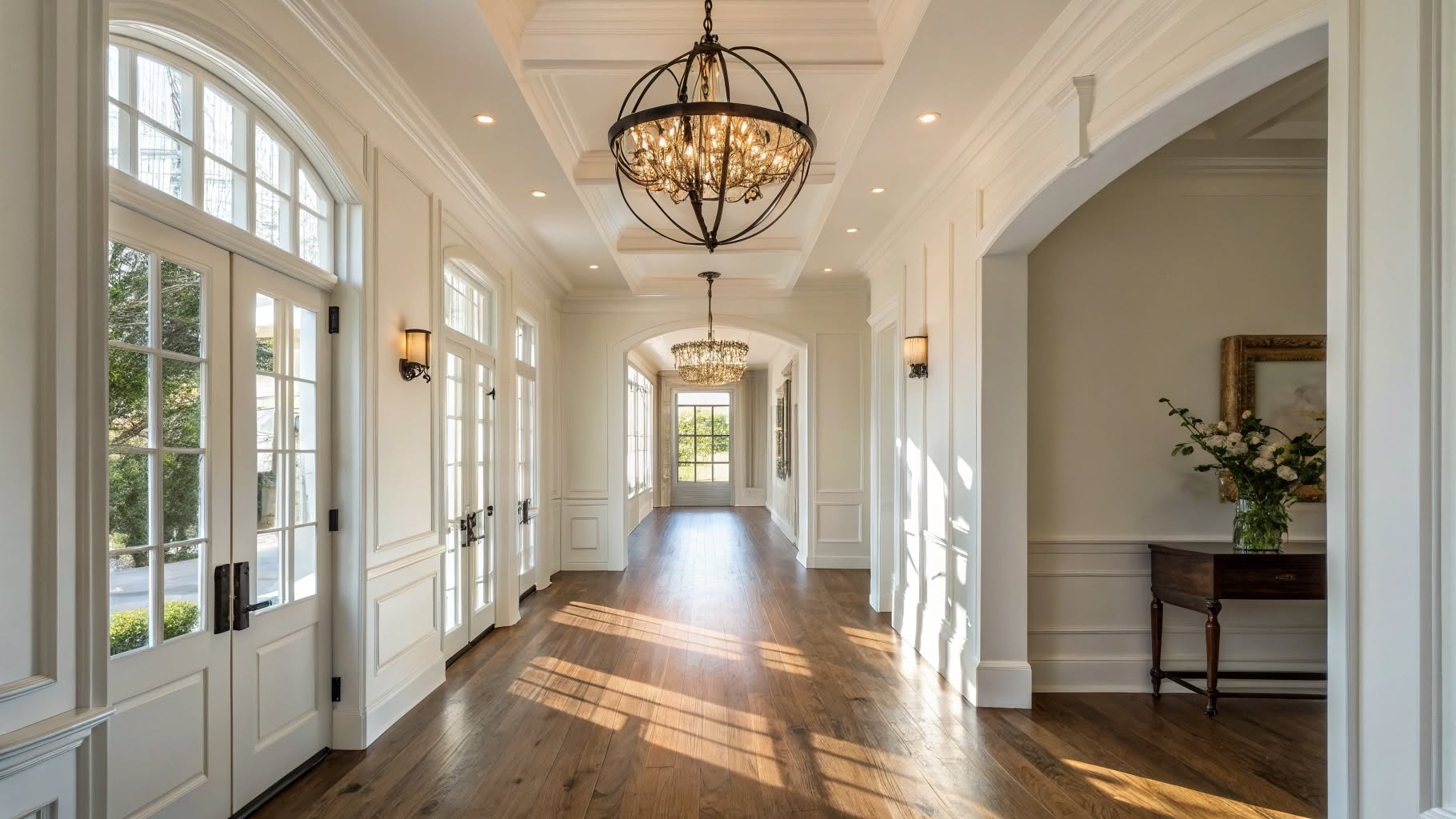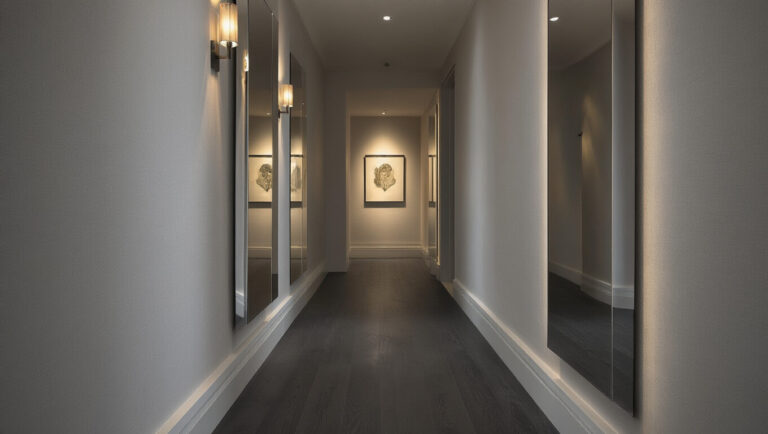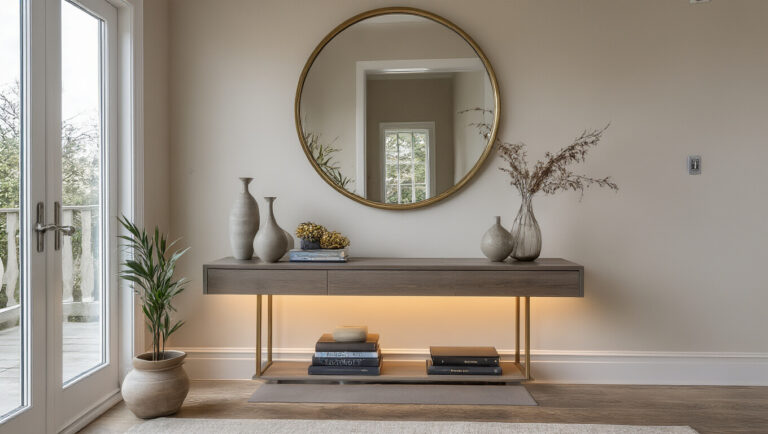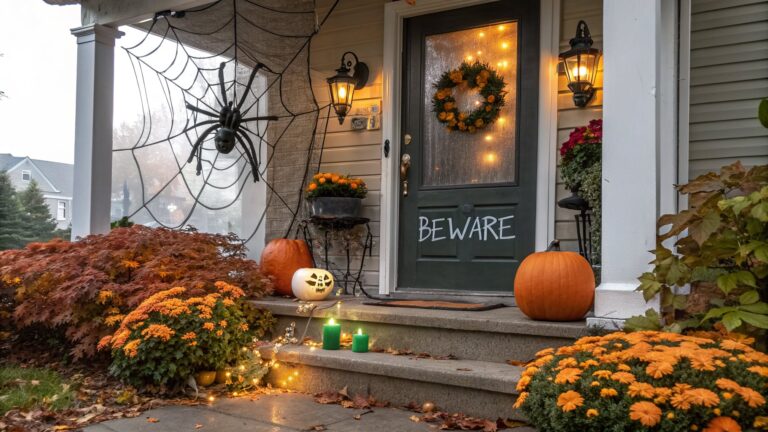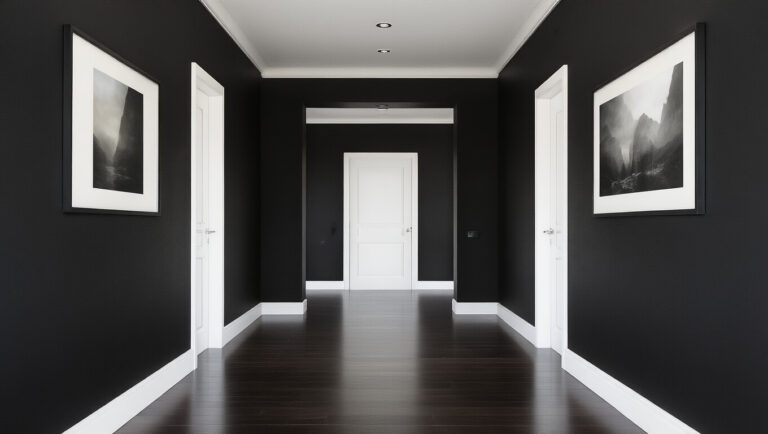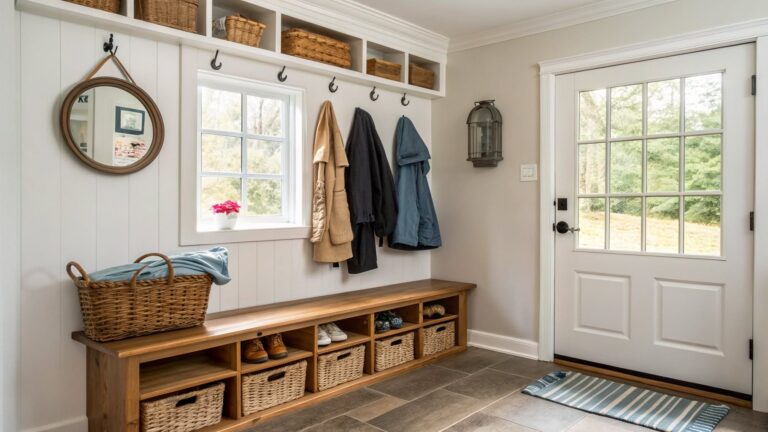Hallway Lighting : Perfect Statement Fixtures For Dark Hallways
Hallways often serve as the unsung heroes of our homes—connecting spaces together while frequently suffering from a lack of natural light. These transitional areas can easily become dark, uninviting passages that we hurry through rather than spaces we appreciate.
The right lighting fixture can transform these overlooked corridors into stunning design statements that welcome guests and family alike. Beyond mere functionality, thoughtfully selected hallway lighting creates ambiance, establishes your home’s aesthetic, and solves the practical challenge of illuminating typically narrow, windowless spaces.
In this guide, we’ll explore nine perfect statement fixtures specifically designed to brighten dark hallways while adding personality and style to these essential pathways in your home. Whether your taste runs contemporary, traditional, or somewhere in between, you’ll discover lighting solutions that combine form and function to make your hallway shine—literally and figuratively.
Understanding Hallway Lighting Challenges
Hallways present unique lighting challenges that require thoughtful solutions. Unlike living rooms or kitchens, hallways typically lack natural light sources and often feature long, narrow dimensions that can create shadows and dark spots. The confined space limits fixture options—chandeliers that work beautifully in foyers might overwhelm a standard hallway, while inadequate lighting can make these passages feel claustrophobic and unwelcoming. Many homeowners also struggle with hallways that serve as galleries for artwork or family photos, requiring lighting that illuminates these personal touches without causing glare or hotspots.
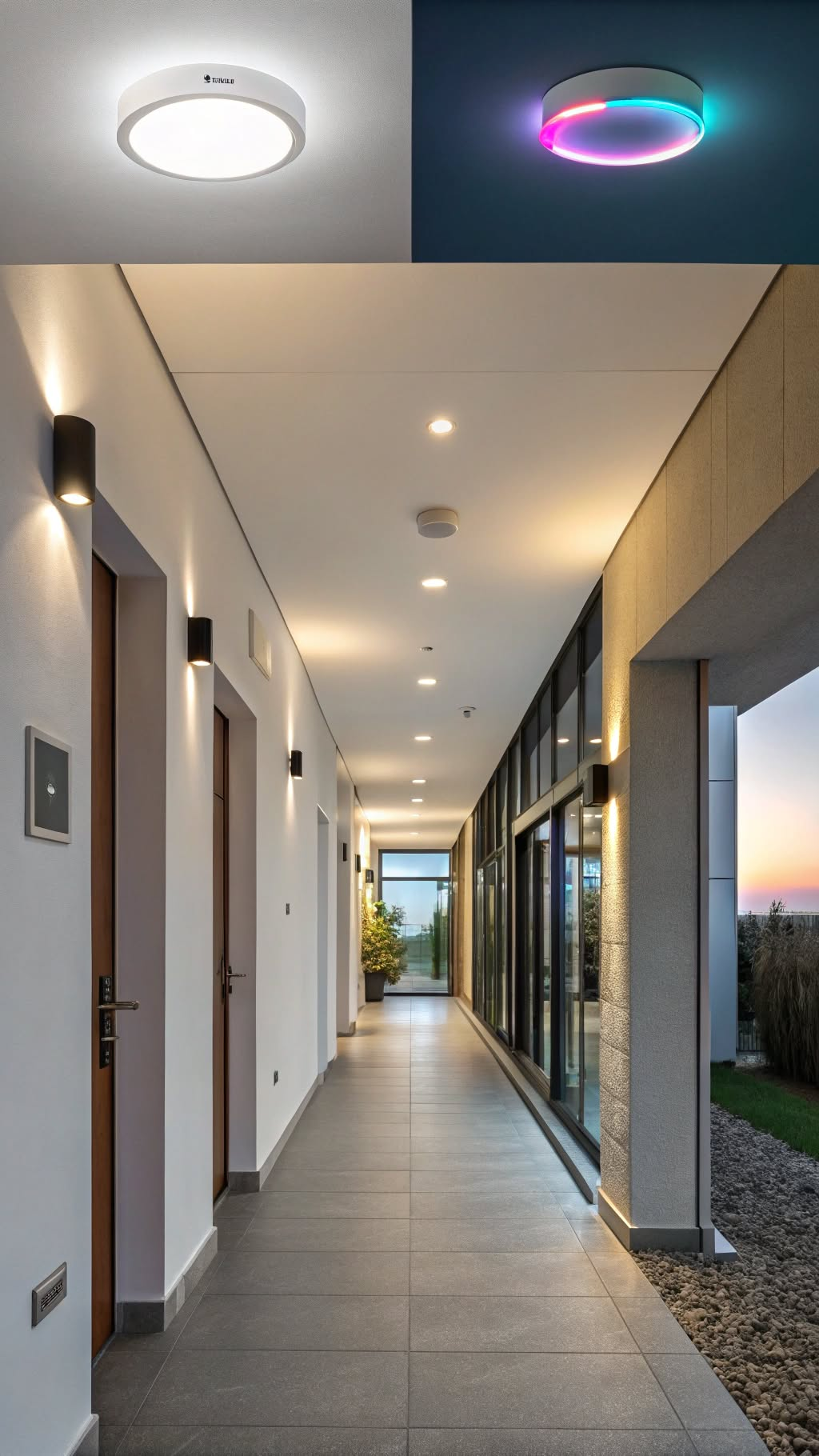
The architecture of hallways further complicates lighting decisions. Ceiling height plays a crucial role in determining appropriate fixture types—low ceilings demand flush or semi-flush mounts, while higher ceilings can accommodate pendant lights or even statement chandeliers. Long hallways may require multiple fixtures to provide consistent illumination throughout, creating the additional challenge of selecting pieces that work harmoniously together. Add to this the technical considerations of wiring locations, switch placement, and the potential need for dimming capabilities, and hallway lighting quickly becomes more complex than it might initially seem.
Beyond these practical concerns lies the design impact of hallway lighting. As transitional spaces that connect various rooms, hallways should complement adjacent areas while potentially serving as design transitions between different zones of your home. The right fixture can establish a visual rhythm that guides visitors through your space, creating moments of interest in otherwise utilitarian corridors. When selected thoughtfully, statement lighting in hallways can transform these passages from afterthoughts into architectural highlights that elevate your entire home’s aesthetic.
Dramatic Pendant Lights and Chandeliers
When ceiling height allows, pendant lights and chandeliers offer perhaps the most dramatic opportunity to make a statement in hallway lighting. These suspended fixtures draw the eye upward, creating visual interest while providing necessary illumination. For narrower hallways, consider linear pendant lights that follow the corridor’s length, creating a cohesive lighting experience that guides movement. In wider hallways or where hallways meet larger spaces, a series of identical pendants installed at equal intervals creates rhythm and consistent light distribution while making a confident design statement. The suspended nature of these fixtures allows the light source to hang closer to eye level, providing better illumination for artwork and creating a more intimate atmosphere than ceiling-mounted alternatives.
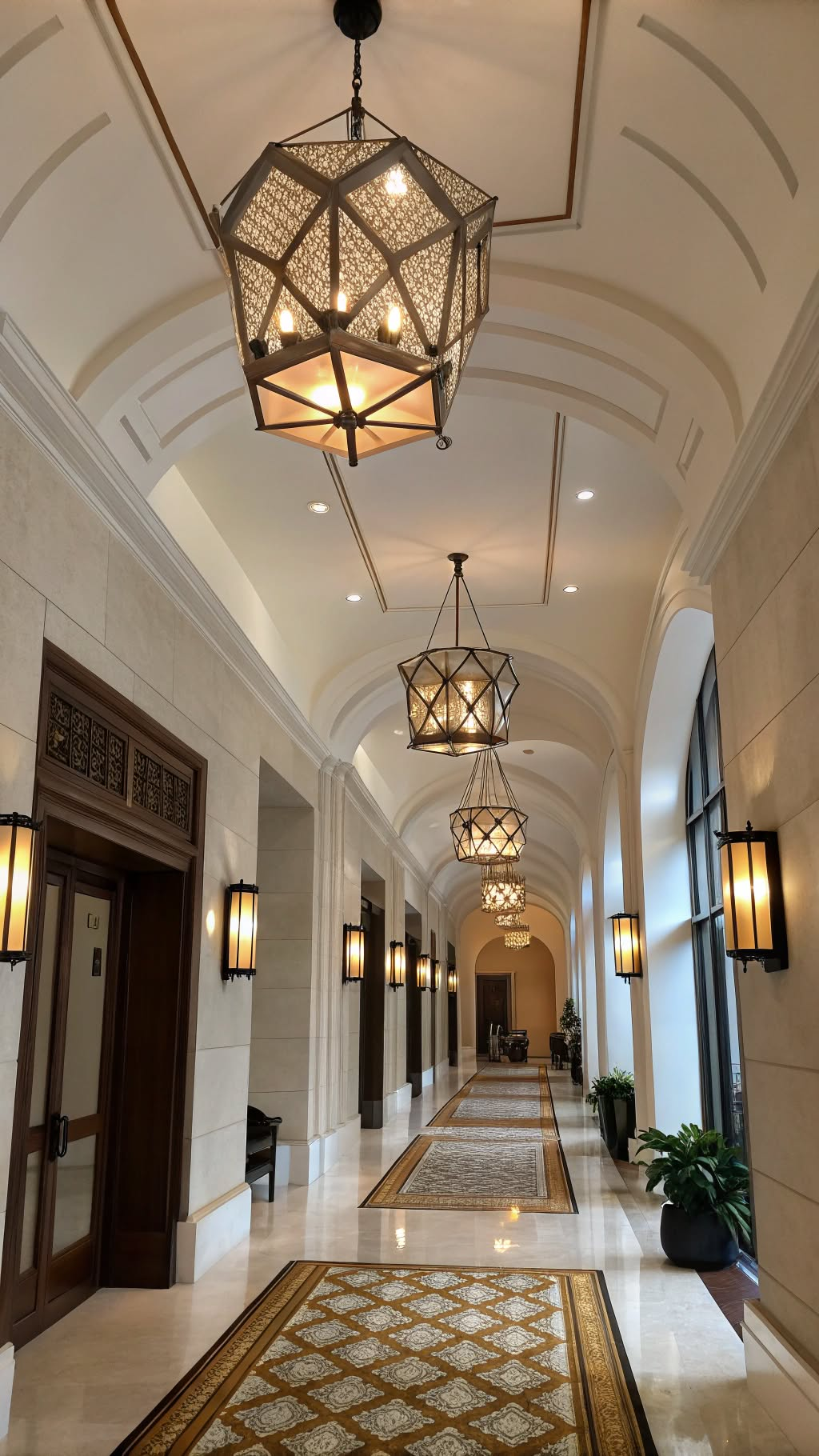
Modern chandeliers have evolved far beyond the crystal and candle designs of previous centuries, though those traditional styles remain available for classical interiors. Today’s statement chandeliers include sculptural pieces with organic forms, geometric metal frameworks, and artistic interpretations that function as illuminated sculptures. For hallways with sufficient width and height, a small to medium chandelier creates an unexpected moment of luxury in a utilitarian space. Look for designs that provide ambient light while minimizing glare—satin glass, fabric shades, or metal designs that direct light upward and downward rather than outward can prevent uncomfortable brightness in narrow passages. Many contemporary chandeliers incorporate LED technology, offering energy efficiency alongside dramatic design.
When selecting pendant lights or chandeliers for hallways, consider scale carefully. The fixture should make a statement without overwhelming the space or creating obstacles. As a general rule, maintain at least 7 feet of clearance between the floor and the bottom of the fixture to prevent both physical and visual obstruction. For longer hallways, multiple smaller pendants often work better than a single large piece, creating points of interest throughout the passage while ensuring even light distribution. If your hallway ceiling features a single junction box but requires multiple light sources, consider track lighting systems with pendant attachments or chandeliers with adjustable arms that can direct light where needed while maintaining a cohesive look.
Flush and Semi-Flush Mounts with Impact
For hallways with lower ceilings or in homes where hanging fixtures might feel imposing, flush and semi-flush mount lighting offers practical solutions without sacrificing style. These ceiling-mounted options sit either directly against the ceiling (flush) or extend slightly downward (semi-flush), making them ideal for spaces with height restrictions while still providing adequate illumination. The market for these practical fixtures has expanded dramatically in recent years, with designers recognizing the need for statement-making options that don’t require significant drop heights. From drum-shaped fixtures with textured fabrics to geometric metal designs with intricate cutouts that cast patterned shadows, today’s flush mounts offer far more than the plain glass ‘boob lights’ that once dominated this category.
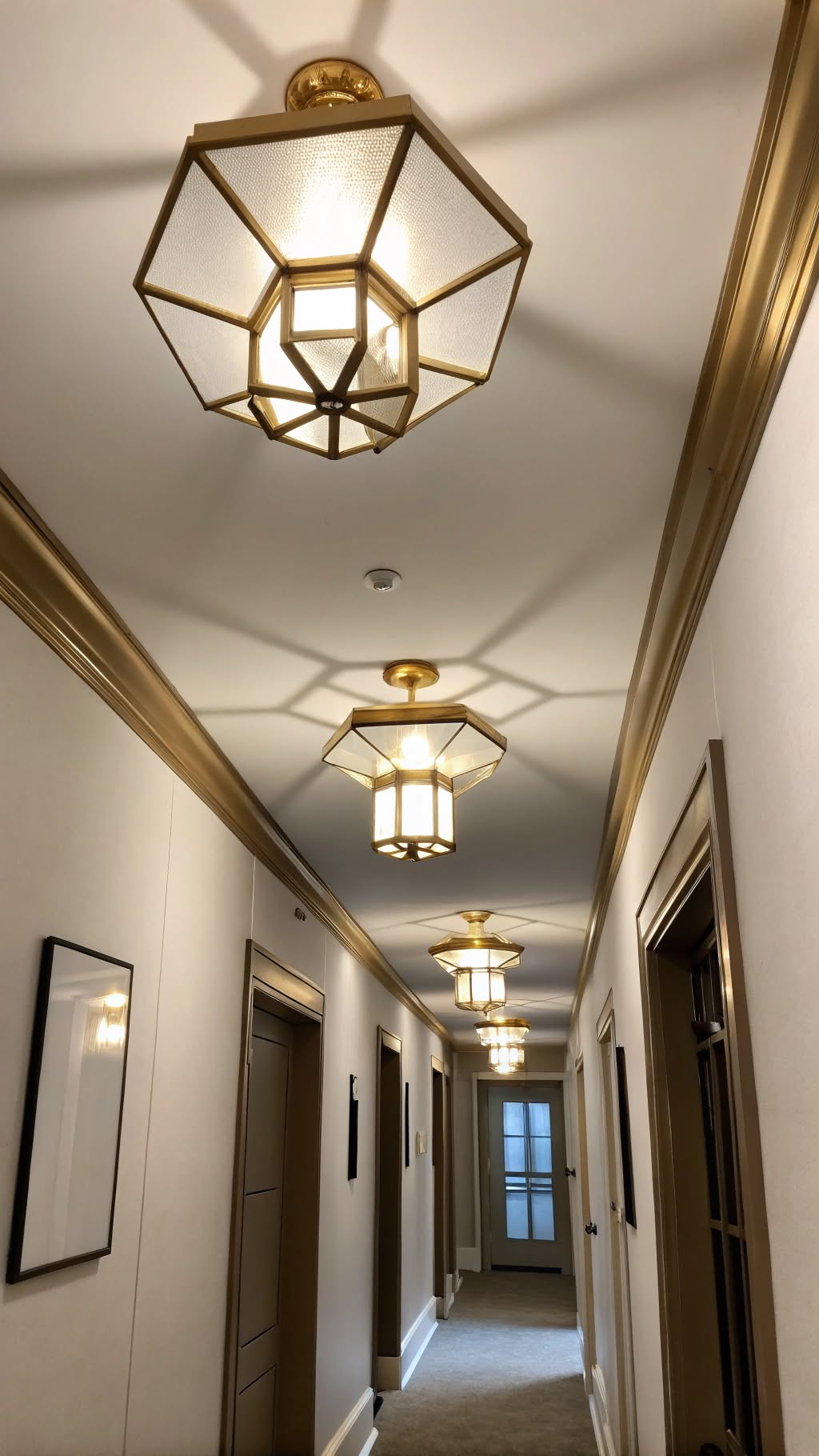
Semi-flush mounts provide slightly more drama than their flush counterparts, extending downward from the ceiling by typically 4-12 inches. This small gap creates interesting shadow play and allows for more elaborate designs without significantly impacting headroom. Look for fixtures with multiple light sources to maximize brightness in dark hallways, or consider designs with glass or translucent materials that allow light to diffuse in multiple directions. Particularly effective are semi-flush fixtures with open designs that direct some light upward toward the ceiling, creating a sense of greater height and airiness in confined hallway spaces. For a cohesive look throughout longer corridors, install multiple identical semi-flush mounts at regular intervals, creating rhythm while ensuring consistent illumination.
The material and finish of flush and semi-flush fixtures significantly impact their statement potential. Brushed brass or matte black finishes offer contemporary sophistication, while fixtures incorporating natural elements like woven rattan, wood, or handblown glass add organic texture and warmth. Consider unexpected materials like concrete, colored glass, or mixed metals for truly unique hallway lighting. Many statement flush mounts play with scale—oversized drum shades or wide geometric forms can create dramatic impact even without the vertical drop of pendants. For hallways with particularly challenging dimensions, look for elongated flush mounts designed specifically for narrow spaces, providing linear light distribution while maintaining a low profile that complements rather than dominates the architecture.
Wall Sconces and Indirect Lighting Solutions
Wall sconces offer a sophisticated alternative or complement to ceiling-mounted fixtures, particularly valuable in hallways with electrical limitations or where architectural features prevent ideal ceiling lighting placement. These wall-mounted fixtures come in countless styles, from sleek contemporary designs to traditional lantern-inspired pieces, allowing for personalization that perfectly complements your home’s aesthetic. In narrower hallways, sconces provide illumination without encroaching on precious space, while in wider corridors, they can be used to frame artwork, highlight architectural details, or create rhythmic light patterns that guide movement through the space. For maximum impact, consider sconces that direct light both upward and downward, creating interesting shadow play while providing more comprehensive illumination than single-direction fixtures.
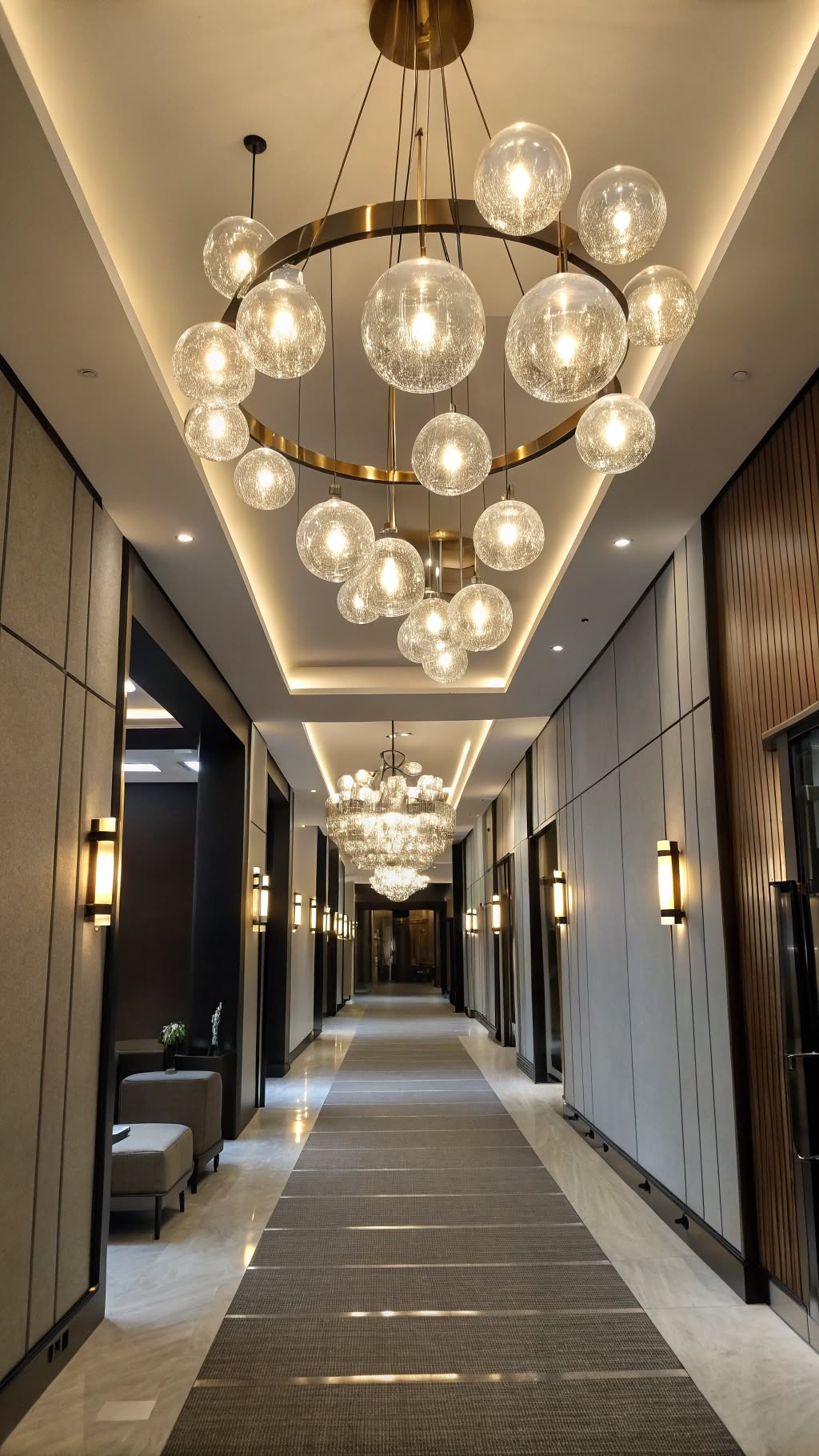
Indirect lighting takes a subtler approach to hallway illumination, concealing the light source while allowing the light itself to become the feature. Cove lighting installed along the junction where walls meet the ceiling creates a floating effect that visually expands the space, perfect for hallways that feel confined or claustrophobic. Similarly, LED strip lighting installed beneath floating shelves, along baseboards, or behind architectural elements provides a contemporary glow that eliminates dark corners while adding dramatic emphasis to your hallway’s best features. These indirect solutions work particularly well in ultra-modern interiors or in historic homes where preserving original architecture takes precedence over adding new fixtures.
The strategic placement of wall lighting transforms hallway functionality while creating design statements. Consider installing pairs of matching sconces at regular intervals along longer hallways, creating gallery-like illumination perfect for displaying artwork. In hallways with interesting architectural features like niches, arches, or textured walls, position uplights to cast dramatic shadows that emphasize these elements. For truly dark hallways, combining wall sconces with ceiling fixtures creates layered lighting that eliminates shadows while adding depth and interest. Smart lighting systems allow these wall-mounted options to serve multiple purposes—bright illumination for practical use, dimmed ambiance for evenings, or even color-changing capabilities for unique visual effects that transform your hallway from merely functional to genuinely extraordinary.
Statement Fixtures for Specific Hallway Types
L-shaped or curved hallways present unique lighting opportunities that straight corridors don’t offer. These architectural transitions create natural focal points where statement fixtures can shine. Consider installing a dramatic pendant or chandelier at the turn of an L-shaped hallway, creating a visual anchor that draws the eye and guides movement through the space. For gently curved hallways, a series of identical fixtures following the curve creates a processional effect that enhances the architectural flow. In both cases, the changing perspective as one moves through the space allows statement fixtures to reveal themselves gradually, creating a dynamic experience that flat, straight hallways can’t match. Complementary wall sconces can further enhance these transitional zones, providing layered lighting that eliminates shadows while emphasizing the hallway’s unique geometry.
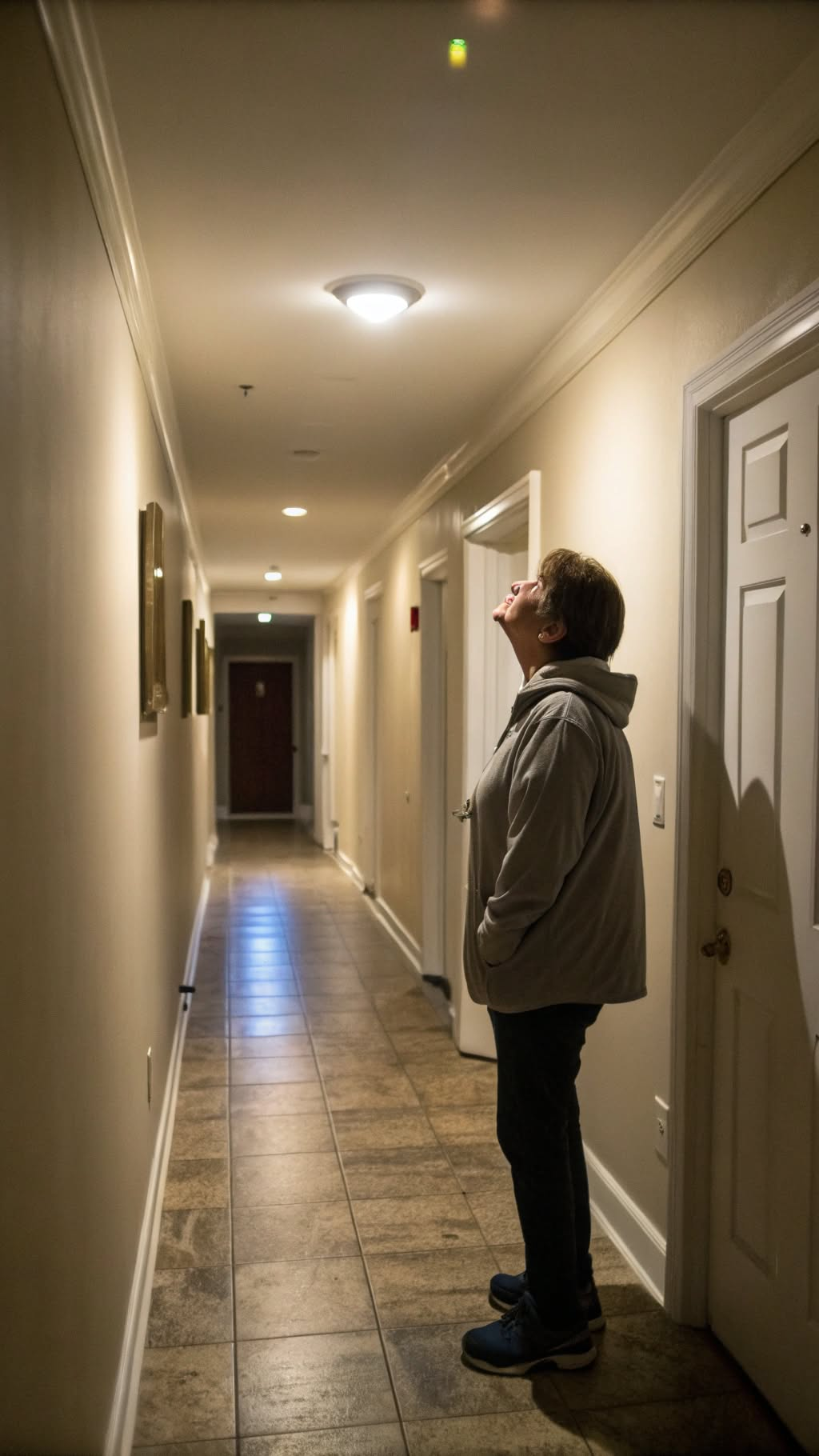
Entrance hallways and foyers serve as visitors’ first impression of your home, making them ideal locations for truly spectacular lighting statements. Since these spaces often feature higher ceilings than interior hallways, they can accommodate larger, more dramatic fixtures. Consider multi-tiered chandeliers, clusters of pendant lights at varying heights, or oversized sculptural pieces that establish your home’s design personality from the moment someone steps inside. These entrance fixtures should provide adequate general illumination while creating ambiance that welcomes guests. Because foyers often open to other spaces, select lighting that complements adjacent rooms while still making its own distinct statement—perhaps incorporating materials, colors, or design elements that will appear throughout the home, creating a cohesive introduction to your interior style.
Hallways leading to private spaces like bedrooms require more nuanced lighting approaches that balance statement-making with practicality. These passages often benefit from lighting with dimming capabilities, allowing for bright illumination when needed while providing softer guidance lighting for nighttime navigation. Consider wall-recessed fixtures that create pools of light along the floor, illuminating the path without disturbing sleeping family members. Alternatively, low-profile flush mounts with warm temperature LEDs create a gentle glow that provides necessary visibility without harsh brightness. Even in these utilitarian contexts, fixtures can make subtle statements through interesting materials, unique forms, or unexpected details that maintain your home’s design standards while prioritizing the functional needs of these more private corridors.
Customizing with Bulbs, Color, and Controls
The impact of any hallway lighting fixture depends significantly on the bulbs it contains. LED technology has revolutionized lighting options, offering unprecedented control over light temperature, brightness, and energy efficiency. For hallways that lack natural light, bulbs with higher Kelvin ratings (5000K-6500K) provide crisp, daylight-quality illumination that makes the space feel brighter and more open. Conversely, bulbs with lower Kelvin values (2700K-3000K) create warmer, more intimate atmospheres reminiscent of traditional incandescent lighting. Many homeowners find that hallways benefit from middle-range temperatures around 3500K-4000K, offering clear visibility without the potential harshness of daylight bulbs. Beyond temperature, consider bulbs with high Color Rendering Index (CRI) ratings, particularly in hallways where artwork is displayed, as these reproduce colors more accurately and make both art and wall colors appear truer to life.

The finish and color of your statement fixtures create dramatic impact even when the lights are off. While neutral metallics like brushed nickel and chrome offer timeless versatility, don’t overlook the statement potential of fixtures in matte black, antique brass, or even powder-coated colors that complement or intentionally contrast with your hallway’s color scheme. For truly unique installations, consider custom-colored fixtures that match specific elements in your home or create deliberate visual tension with surrounding finishes. Remember that hallway lighting exists in relation to adjacent spaces—selecting fixtures that reference materials or colors used in connecting rooms creates cohesion throughout your home while still allowing the hallway lighting to make its own distinct statement.
Smart lighting controls elevate hallway fixtures from merely decorative to genuinely intelligent design features. Motion sensors provide practical hands-free illumination for hallways frequently traversed with full arms or by children who can’t reach switches. Programmable systems can adjust brightness and even color temperature throughout the day, transitioning from energizing morning light to relaxing evening ambiance without requiring manual adjustments. For homes with artwork in hallways, specialized control systems can protect valuable pieces by automatically adjusting brightness based on ambient light conditions or time-based programs. The ultimate hallway lighting luxury comes through scene-setting capabilities, where a single command transforms your hallway lighting from practical task illumination to dramatic mood lighting for entertaining, or to gentle navigation lighting that guides late-night movement without disrupting sleep patterns.
Conclusion
The humble hallway, often overlooked in home design considerations, holds tremendous potential as a canvas for lighting creativity. The nine statement fixture approaches we’ve explored—from dramatic pendants and chandeliers to sophisticated flush mounts, artistic wall sconces, and smart lighting solutions—demonstrate that even the darkest corridor can be transformed into a design highlight with the right illumination strategy.
By viewing your hallway lighting as an opportunity rather than an afterthought, you’ll create passages that family and guests linger in rather than merely pass through. Whether you’re renovating an existing home or building from scratch, invest time in finding statement lighting that transforms your hallways from functional necessities into showcase spaces that reflect your design sensibility and enhance your daily experience of moving through your home. Your hallways deserve to shine as brightly as the rooms they connect—and with these lighting approaches, they absolutely will.
